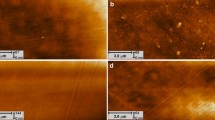Abstract
The opsonic requirements for phagocytosis in suspension of 38 clinical isolates of coagulasenegative staphylococci recovered from neonates with septicemia were found to be related to the degree of surface hydrophobicity of these strains. Sixteen isolates were adequately opsonized only in the presence of complement; this group was significantly more hydrophobic (p<0.001) than the 22 strains not requiring complement for efficient uptake in suspension. Evidence showed that hydrophobic groups present on the bacterial surface may interfere with IgG opsonization. In contrast, IgG sufficed as an opsonin without complement being required for the efficient uptake of these hydrophobic strains when adhering to a polymer surface.
Similar content being viewed by others
References
Battisti, O., Mitchison, R., Davies, P.A. Changing blood culture isolates in a referral neonatal intensive care unit. Archives of Diseases in Childhood 1981, 56: 775–778.
Baumgart, S., Hall, S.E., Campos, J.M., Polin, R.A. Sepsis with coagulase-negative staphylococci in critically ill newborns. American Journal of Diseases in Children 1983, 137: 461–463.
Fleer, A., Senders, R.Ch., Visser, M.R., Bijlmer, R.P., Gerards, L.J., Kraaijeveld, C.A. Verhoef, J. Septicemia due to coagulase-negative staphylococci in a neonatal intensive care unit: clinical and bacteriological features and contaminated parenteral fluids as a source of sepsis. Pediatric Infectious Disease 1983, 2: 426–432.
Munson, D.P., Thompsom, T.R., Johnson, D.E., Rhame, F.S., VanDrunen, N., Ferrieri, P. Coagulase-negative staphylococcal septicemia: experience in a newborn intensive care unit. Journal of Pediatrics 1982, 101: 602–605.
Christensen, G.D., Bisno, A.L., Parisi, J.T., McLaughlin, B., Hester, M.G., Luther, R.W. Nosocomial septicemia due to multiply antibiotic-resistantStaphylococcus epidermidis. Annals of Internal Medicine 1982, 96: 1–10.
Marrie, T.J., Costerton, J.W. Scanning and transmission electron microscopy of in situ bacterial colonization of intravenous and intraarterial catheters. Journal of Clinical Microbiology 1984, 19: 687–693.
Hogt, A.H., Dankert, J., de Vries, J.S., Feijen, J. Adhesion of coagulase-negative staphylococci to biomaterials. Journal of General Microbiology 1983, 129: 2959–2968.
Hogt, A.H., Dankert, J., Hulstaert, C.E., Feijen, J. Cell surface characteristics of coagulase-negative staphylococci and their adherence to fluorinated poly (ethylenepropylene). Infection and Immunity 1986, 51: 294–301.
Pascual, A., Fleer, A., Westerdaal, N.A.C., Verhoef, J. Modulation of adherence of coagulase-negative staphylococci to teflon catheters in vitro. European Journal of Clinical Microbiology 1986, 5: 518–522.
Peters, G., Locci, R., Pulverer, G. Adherence and growth of coagulase-negative staphylococci on surfaces of intravenous catheters. Journal of Infectious Diseases 1982, 146: 479–482.
Christensen, G.D., Simpson, W.A., Bisno, A.L., Beachey, E.H. Adherence of slime-producing strains ofStaphylococcus epidermidis to smooth surfaces. Infection and Immunity 1982, 37: 318–326.
Johnson, G.M. Lee, D.A., Regelmann, W.E., Gray, E.D., Peters, G., Quie, P.G. Interference with granulocyte function byStaphylococcus epidermidis slime. Infection and Immunity 1986, 54: 13–20.
Gray, E.D., Peters, G., Verstegen, M., Regelmann, W.E. Effect of extracellular slime substance fromStaphylococcus epidermidis on the human cellular immune response. Lancet 1984, i: 365–367.
Peterson, P.K., Wilkinson, B.J., Kim, Y., Schmeling, D., Douglas, S.D., Quie, P.G., Verhoef, J. The key role of peptidoglycan in the opsonization ofStaphylococcus aureus. Journal of Clinical Investigation 1978, 61: 597–609.
Verbrugh, H.A., Peterson, P.K., Nguygen, B.T., Sisson, S.P., Kim, Y. Opsonization of encapsulatedStaphylococcus aureus: the role of specific antibody and complement. Journal of Immunology 1982, 129: 1681–1687.
Verbrugh, H.A., van Dijk, W.C., Peters, R., van Erne, M.E., Daha, M.R., Peterson, P.K., Verhoef, J. Opsonic recognition of staphylococci mediated by cell wall peptidoglycan: antibody-independent activation of human complement and opsonic activity of peptidoglycan antibodies. Journal of Immunology 1980, 124: 1167–1173.
Verhoef, J., Peterson, P.K., Kim, Y., Sabath, L.D., Quie, P.G. Opsonic requirements for staphylococcal phagocytosis: heterogeneity among strains. Immunology 1977, 33: 191–197.
Lee, D.A., Hoidal, J.R., Clawson, C.C., Quie, P.G., Peterson, P.K. Phagocytosis by polymorphonuclear leukocytes ofStaphylococcus aureus andPseudomonas aeruginosa adherent to plastic, agar or glass. Journal of Immunological Methods 1983, 63: 103–114.
Vandenbroucke-Grauls, C.M.J.E., Thijssen, H.M.W.M., Verhoef, J. Interaction between human polymorphonuclear leukocytes andStaphylococcus aureus in the presence and absence of opsonins. Immunology 1984, 52: 427–435.
Kloos, W.E., Schleifer, K.H. Simplified scheme for routine identification of humanStaphylococcus species. Journal of Clinical Microbiology 1975, 1: 82–88.
Verhoef, J., Peterson, P.K., Quie, P.G. Kinetics of staphylococcal opsonization, attachment, ingestion and killing by human polymorphonuclear leukocytes: a quantitative assay using3H-thymidine labeled bacteria. Journal of Immunological Methods 1977, 14: 303–311.
Roord, J.J., Daha, M., Kuis, W., Verbrugh, H.A., Verhoef, J., Zegers, B.J.M., Stoop, J.W. Inherited deficiency of the third component of complement associated with recurrent pyogenic infections, circulating immune complexes and vasculitis in a Dutch family. Pediatrics 1983, 71: 81–87.
Boyum, A. Isolation of mononuclear cells and granulocytes from human blood. Scandinavian Journal of Clinical and Laboratory Investigation 1968, 97, Supplement: 77–89.
Verbrugh, H.A., van Dijk, W.C., Peters, R., van der Tol, M.E., Verhoef, J. The role ofStaphylococcus aureus cell-wall peptidoglycan, teichoic acid and protein A in the processes of complement activation and opsonization. Immunology 1979, 37: 615–621.
Peterson, P.K., Verhoef, J., Sabath, L.D., Quie, P.G. Effect of protein A on staphylococcal opsonization. Infection and Immunity 1977, 15: 760–764.
Clark, L.A., Easmon, C.S.F. Opsonic requirements ofStaphylococcus epidermidis. Journal of Medical Microbiology 1986, 22: 1–7.
Zimmerli, W., Waldvogel, F.A., Vaudaux, P., Nydegger, U.E. Pathogenesis of foreign body infection: description and characteristics of an animal model. Journal of Infectious Diseases 1982, 146: 487–497.
Zimmerli, W., Lew, P.D., Waldvogel, F.A. Pathogenesis of foreign body infection. Evidence for a local granulocyte defect. Journal of Clinical Investigation 1984, 73: 1191–1200.
Fleer, A., Gerards, L.J., Aerts, P., Westerdaal, N.A.C., Senders, R.Ch., van Dijk, H., Verhoef, J. Opsonic defense toStaphylococcus epidermidis in the premature neonate. Journal of Infectious Diseases 1985, 152: 930–937.
Miller, M.E. Phagocyte function in the neonate: selected aspects. Pediatrics 1979, 64, Supplement: 709–712.
Author information
Authors and Affiliations
Rights and permissions
About this article
Cite this article
Pascual, A., Fleer, A., Westerdaal, N.A.C. et al. Surface hydrophobicity and opsonic requirements of coagulase-negative staphylococci in suspension and adhering to a polymer substratum. Eur. J. Clin. Microbiol. Infect. Dis. 7, 161–166 (1988). https://doi.org/10.1007/BF01963070
Issue Date:
DOI: https://doi.org/10.1007/BF01963070




